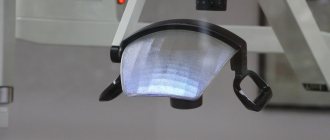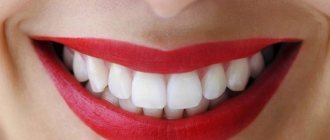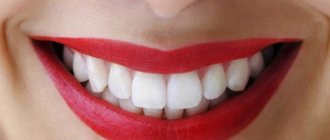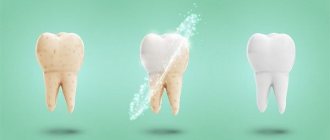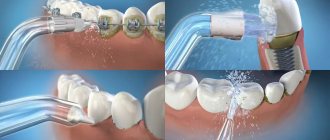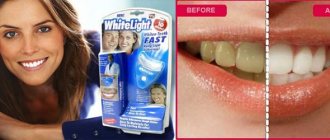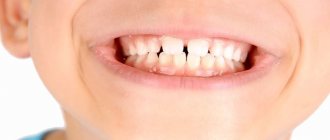1469
The desire to have a beautiful smile that reveals even, snow-white teeth is completely natural.
However, insufficient hygiene procedures, incorrectly selected oral care products, as well as many other factors lead to the fact that the enamel - the protective shell of the teeth - darkens or acquires a yellowish-brown tint over time.
One of the most popular substances for lightening tooth enamel is considered to be ordinary baking soda, which is used both independently and in combination with other components.
How does baking soda affect teeth?
Soda is a good and inexpensive disinfectant. Even now, doctors recommend using it in dental treatment of infants who are diagnosed with stomatitis or oral thrush.
Soda kills fungus and promotes rapid healing of ulcers on the mucous membrane that appear as a result of stomatitis due to its high regenerative properties. In addition, sodium bicarbonate has a pronounced anti-inflammatory effect. Dentists often prescribe rinses or baths with soda or soda-saline solution for purulent periodontitis and pulpitis, after opening the cavity of the affected tooth.
In America, clinical observations of the oral health of patients using soda pastes for brushing their teeth and microbiological analyzes of the contents from the oral cavity of these patients showed that the concentration of pathogenic microorganisms is significantly reduced.
Whitening effect of brushing teeth with baking soda
As for hard tooth tissues, soda has a good whitening effect . The enamel is lightened by at least 0.5 shades, which can be compared with professional oral hygiene. This happens thanks to abrasive particles that efficiently clean the tooth surface from dental plaque and food debris. Conventionally, you can compare brushing your teeth with soda to cleaning various surfaces with sandpaper.
American scientists even conducted a study in 2008 that showed that pastes based on baking soda are much better at removing dental plaque than pastes with a soda-free composition or a low concentration.
It is necessary to take into account the fact that soda is a pure abrasive. Abrasive particles are found in many toothpastes, especially whitening ones. Dentists do not recommend using whitening toothpastes for longer than 2 weeks, because... abrasive particles can thin the enamel layer of the tooth, leading to hypersensitivity. For this reason, pure abrasive in the form of baking soda definitely cannot be used often . Dentists also do not recommend using soda in dry, undiluted form.
You also need to pay attention to the pH of the soda. It is equal to 8, which is typical for an alkaline environment. Many people are afraid of this indicator, but it is only dangerous for the protective barrier of the skin, which is manifested by redness around the mouth if soda pastes act on the skin for a long time. For the oral cavity, an alkaline environment, on the contrary, is positive, because it neutralizes acidity. It is high acidity that contributes to the destruction of hydroxyapatites in the enamel, which act as a kind of skeleton, thereby disrupting the structure of hard tissues and provoking the development of caries and its complications in the future.
Soda teeth whitening:
The benefits and harms of cleaning
Only baking soda is suitable for teeth!
The advantages of sodium bicarbonate pastes include:
- Achieving a positive result quickly, the enamel becomes lighter after the first procedure.
- Easy to prepare pasta and use it.
- Removal of all dental plaque.
- Low cost.
- Relief of unpleasant odor from the oral cavity.
- Relief of inflammatory processes in the oral cavity.
- Accelerated healing of wounds in the mouth.
- Neutralization of acidity in the mouth.
- Destruction of pathogenic microorganisms and fungi of the genus Candida that cause candidiasis (thrush).
There are also disadvantages :
- High abrasive properties. Frequent use of soda contributes to the thinning of the enamel layer and the development of the carious process in the future.
- Irritating effect on soft tissues in the form of red spots or rashes around the mouth.
- Risk of developing bleeding gums.
- The appearance of sensitivity to hot, cold and sour with frequent use of the soda bleaching procedure.
- The short duration of the achieved result.
Important! To prevent the development of these shortcomings, it is not recommended to use products with sodium bicarbonate more than once every 3-4 weeks.
Indications and contraindications for home whitening
Before bleaching yourself, you need to pay attention to the condition of the enamel. This will avoid the negative consequences of the procedure.
Home whitening can only be used if the following conditions are met:
- All teeth are healthy, there are no caries or enamel defects. Visit your dentist before whitening.
- There is no damage to the mucous membranes of the mouth and gums. Homemade whitening products are bad for your gum health and can worsen existing problems.
- There is no allergy to components of bleaching products.
Whitening with folk remedies is also contraindicated for pregnant and lactating women, teenagers, and people who have many fillings and crowns in their mouth.
If there are contraindications, safe whitening at the dentist is the best choice.
Before whitening at the dental clinic, doctors conduct a complete examination of the oral cavity. The decision about the possibility of bleaching is made based on examination and additional diagnostic methods - computed tomography and radiography.
After this, the dentist draws up a plan to restore the whiteness of the enamel. It may include treatment of caries, replacement of fillings, hygienic cleaning, polishing, ultrasonic cleaning using the Air Flow method.
Whitening in dentistry is carried out only after examination and study of the characteristics of the enamel and the condition of the patient’s gums. The dentist selects bleaching agents of the required concentration, drugs to protect and restore enamel.
The independent use of bleaching products is prescribed by a doctor after professional cleaning and bleaching. They help consolidate and maintain the effect of the procedure. You can find out the price and sign up for professional teeth whitening by calling the phone numbers listed on the website or on the service page.
Indications for using soda
Soda must be used when the enamel darkens due to plaque formation
The main indication for using soda pastes when brushing teeth is darkening of the enamel.
The following factors contribute to darkening:
- Consumption of foods and drinks with food colorings.
- Smoking.
- Age.
- Poor oral hygiene.
Baking soda can combat these reasons.
But there are reasons that can only be eliminated by professional, internal tooth whitening. These include:
- Tooth injury.
- Consequences of endodontic treatment.
- Taking certain medications.
- Genetics.
In these cases, the darkening of the enamel begins from the inside, and superficial whitening methods will not give even minimal results.
Video experiment to identify the effect of soda and salt on teeth:
Contraindications
This method has contraindications. It is not applicable for those who have:
- Increased sensitivity of teeth. The already thin layer of enamel from this procedure can be destroyed irreparably.
- Caries. Whitening ingredients, once in a carious cavity, increase its size.
- Gum diseases. Their condition may be aggravated by exposure to acid and alkali.
- Disturbed acid-base balance.
Before the whitening procedure, you need to familiarize yourself with these points. You should choose another whitening method if at least one of them is applicable to this case.
Rules of application
To achieve white teeth without damaging the enamel layer of the tooth, you need to use sodium bicarbonate a maximum of once a month. In this case, you need to use it mixed with water, the consistency should be mushy. You can use any other solvent.
Attention! Do not use dry soda under any circumstances; it can leave scratches on the enamel layer.
This is what the paste should look like
In addition, dry soda powder feels like sand in the mouth, which causes discomfort. It is better to use the product in diluted form, mixing it with toothpaste or other substance.
There are several proven recipes for preparing homemade soda pastes and solutions, which will be discussed below.
The method of brushing your teeth can be standard, but it is better to use circular movements of the brush. This will not only clean the tooth surfaces, but also massage the gums, improving tissue trophism.
Is it possible to brush your teeth with baking soda every day?
Dentists have a negative attitude towards any abrasive products, therefore, from a professional point of view, daily brushing of teeth with soda is prohibited. It was already mentioned above that daily use leads to destructive processes in tooth tissue, but people still strive to achieve positive dynamics and consolidate this result for a long time.
Carefully! It is impossible to achieve a lasting result with whitening soda. Excessive efforts will lead to other dental problems that cannot be treated at home.
The effect after brushing teeth with soda does not last long, which explains the desire of patients to use this method of hygiene more often. However, daily use thins the enamel more and more. Dentin, which is much darker, begins to appear through the thin enamel layer.
As a result, the teeth become even darker than they were before and it will no longer be possible to achieve lightening at home. In addition, thin enamel easily allows waste products of pathogenic microflora, which are the source of the development of most dental diseases, to pass through it.
Dentist on brushing teeth with soda:
Is it possible to brush your child's teeth with baking soda?
It is better not to brush teeth with a milk bite with soda. There are several reasons for this:
- The enamel is already white and does not need bleaching.
- The enamel is not fully formed and is very porous, which can contribute to its rapid destruction.
Traditional folk whitening methods
There are several ways to whiten teeth using traditional recipes. The most common of them are soda, activated carbon, hydrogen peroxide, and tea tree oil. Why isn't this the best solution?
- Baking soda – This is often used to remove soft plaque from the surface of enamel. To do this, mix a small amount of soda with water to a soft paste and brush your teeth with it instead of toothpaste. At the same time, teeth whitening at home with baking soda can harm the enamel. Soda is an abrasive, and it does not affect the color of teeth, but only removes plaque, leaving microcracks on the surface of the enamel.
- The second popular remedy is hydrogen peroxide. This type of home teeth whitening is dangerous and can cause a chemical burn to the oral mucosa. The use of hydrogen peroxide is also prohibited if there are fillings, dentures, or untreated caries.
- Charcoal has been used as a dental cleanser since before the advent of toothpastes. However, now the use of activated carbon is unjustified. Charcoal, like baking soda, leaves microcracks on the enamel and also does not affect the color, removing only surface plaque. After cleaning with activated carbon, the enamel surface becomes rough, so microbial and pigment deposits settle on it even more.
- Teeth whitening at home with lemon is another popular method of achieving a snow-white smile. But lemon juice can negatively affect the enamel and cause increased sensitivity. Citric acid leaches calcium from the surface layer of enamel. This will make your teeth appear lighter. However, after whitening with lemon, the surface of the teeth will become rough, increased sensitivity appears, and the enamel’s resistance to mechanical damage and the effects of pathogenic bacteria decreases.
- Tea tree oil does not whiten teeth. However, it is good for gum health (relieves inflammation), has an antimicrobial effect and improves bad breath. However, tea tree oil is not recommended for use by children and pregnant women.
- Iodine, strawberries, coconut pulp, a mixture of banana and resin, olive oil, table salt, milk powder, and herbal decoctions are used as bleaching agents. However, the effectiveness of such products is very low, and some substances are unsafe for health.
Before resorting to traditional recipes, it is recommended to consult a doctor. The dentist will give detailed instructions on how to whiten your teeth safely at home and recommend professional products.
How to brush your teeth with soda
Before you start brushing your teeth with soda, you need to be completely sure that:
- The enamel is of sufficient thickness.
- The enamel is free of microcracks.
- There is no hypersensitivity.
- Darkening of the enamel layer is not associated with genetic factors, injury or medications.
Personal hygiene products used to clean dental surfaces with soda pastes:
- A toothbrush with soft bristles (some dentists recommend not using a brush at all, but replacing it with a bandage, a cotton swab, or simply using your index finger to brush).
- Toothpaste (non-whitening), water, lemon juice or hydrogen peroxide.
Cleaning technique:
- Combine baking soda with one of the ingredients: water, toothpaste or lemon juice until it becomes mushy.
- Place the mixture on the head of your toothbrush.
- Clean dental surfaces using circular movements, without much force.
- Duration of cleaning is up to 3 minutes (if water or toothpaste is used as a solvent), no more than 1 minute (if the solvent is lemon juice or hydrogen peroxide).
- Rinse your mouth vigorously with running water or a mint or herbal mouthwash to remove the unpleasant aftertaste.
Recipe options
The most popular recipes using soda are:
| Soda with lemon juice | There are recipes for paste and solution. To prepare the paste, you need to combine a teaspoon of sodium bicarbonate with the juice squeezed from fresh lemon. Add juice drop by drop until a paste consistency is reached. The paste copes with plaque much better than the solution. The rinsing method lightens the enamel slightly. To do this, the juice of one lemon is mixed with a teaspoon of baking soda. |
| Soda with toothpaste | To prepare the composition, you need to use equal amounts of toothpaste and soda, and the toothpaste should contain fluorides, which strengthen the enamel, and potassium nitrate, which reduces sensitivity. |
| Baking soda and hydrogen peroxide | To prepare the paste, you need to take 1 teaspoon of baking soda and ½ teaspoon of peroxide. |
Video about teeth whitening with baking soda and peroxide:
Homemade pastes with soda
- If there is a large amount of plaque covering more than half of the dental crowns, you can prepare a powerful paste. It consists of hydrogen peroxide, soda, salt and industrial toothpaste in equal parts.
Soda
Salt
Toothpaste
- If inflammation of the soft tissues of the oral cavity occurs frequently , you can use a homemade eucalyptus-based paste. The ingredients include warm olive oil (2 teaspoons), finely chopped and grated eucalyptus leaves (1 teaspoon), baking soda (1 teaspoon) and a teaspoon of fine salt.
Olive oil
Eucalyptus leaves Soda Salt
- If you are prone to developing tartar, you can prepare a paste with more aggressive abrasive particles. To prepare you will need 20 grams of soda, 45 grams of chalk, 50 grams of white clay and peppermint essential oil (10 drops).
Soda
Chalk
White clay
Peppermint essential oil
Preparation of soda solutions for brushing teeth
To whiten tooth enamel, you can use combined formulations. For example, a solution with hydrogen peroxide is often used. To prepare the solution, take a little 3% hydrogen peroxide and mix with soda until a thick, homogeneous mass is obtained. It is recommended to brush your teeth with this product for no more than 2–3 minutes. After brushing, rinse your mouth thoroughly with warm water.
Another combination cleaner option is baking soda and lemon juice. Add a few drops of lemon juice to a small amount of powder. Brush your teeth with this solution for no longer than 3 minutes, and then rinse your mouth thoroughly. The resulting mixture is very aggressive to tooth enamel and can cause significant harm. Therefore, you can only use this recipe if your teeth are completely healthy.
There is an option in which all 3 ingredients mentioned above are mixed: baking soda, lemon juice and hydrogen peroxide solution. This mixture must be prepared with special care in precise proportions. Take 1/2 tsp. soda, 1/2 tsp. lemon juice and 5 drops of 3% peroxide solution. It is prohibited to use a brush in this case. Apply the mixture with your finger to the surface of your teeth. Try to do this as carefully as possible, avoiding the solution getting on your gums. After 2-3 minutes, rinse your mouth thoroughly with warm water. After using this mixture, it is recommended to refrain from eating hot and cold foods and drinks for several hours, as the sensitivity of the enamel will increase.
And another option for preparing a teeth whitening solution is a combination of baking soda and strawberries. Take 2-3 strawberries, mash them until smooth and mix with a small amount of powder. To brush your teeth with this mixture, it is better to use a brush with soft bristles.
Category Hygiene Published by Mister stomatolog
Effect
The result of using a homemade paste based on sodium bicarbonate is noticeable after the first cleaning. The enamel is lightened by at least 0.5 tones. At the same time, soda can cope not only with soft plaque.
Before and after teeth whitening with baking soda
The paste also effectively removes pigmented plaque and tartar. However, the effect is short-lived . The enamel returns to its original shade after 2 – 3 days.
Video review of brushing teeth with soda:
How to minimize damage to enamel
You can brush your teeth with baking soda using your finger.
To reduce the risk of enamel damage, you should adhere to the following recommendations :
- Brush your teeth with baking soda no more than once a month.
- Use a soft-bristled toothbrush for cleaning, or better yet, a cotton swab, gauze, or simply brush your teeth with your finger.
- On other days, it is better to perform oral hygiene with therapeutic and prophylactic pastes containing useful minerals.
- If even a slight sensitivity appears from the procedure of brushing teeth with soda, it is better to refuse altogether.
